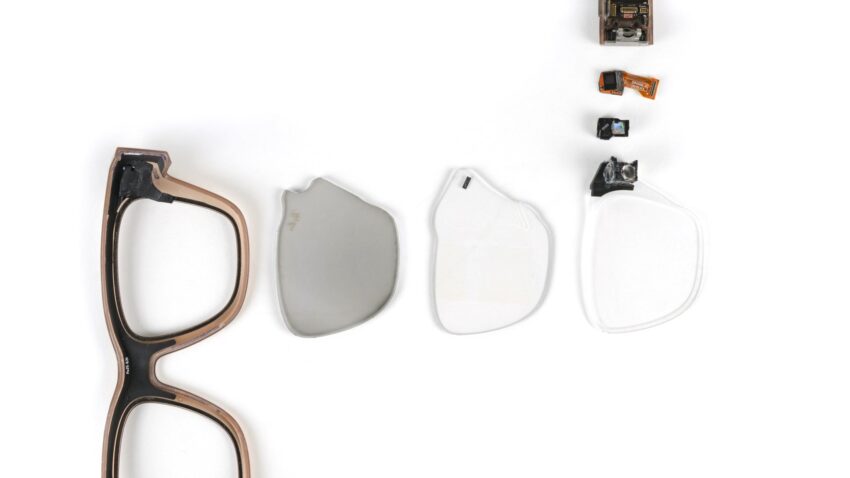
the meta ray-ban display s most interesting The recent teardown of Meta’s Ray-Ban Display glasses by iFixit has unveiled intriguing insights into their innovative glass technology.
the meta ray-ban display s most interesting
Overview of the Meta Ray-Ban Display
Meta’s Ray-Ban Display smart glasses represent a significant step in the evolution of augmented reality (AR) wearables. Launched as a collaboration between Meta and Ray-Ban, these glasses are designed to blend style with functionality, allowing users to experience digital content seamlessly integrated into their everyday lives. However, the real innovation lies not just in the electronics but in the advanced glass technology that enables the display capabilities.
Innovative Glass Technology
According to iFixit’s teardown, the standout feature of the Ray-Ban Display glasses is their glass lenses, which utilize a reflective geometric waveguide system. This technology is crucial for delivering a clear image to the wearer while minimizing visibility to onlookers. The waveguide system employs partially reflective mirrors that direct light at specific angles, ensuring that the display content is primarily visible to the user.
How the Geometric Waveguide Works
The geometric waveguide technology differs significantly from older AR systems that rely on diffractive optics. In traditional diffractive systems, light is bent and split, which can lead to visual artifacts such as rainbow effects or “eye glow” that can be distracting for both the wearer and those around them. The Ray-Ban Display’s waveguide system mitigates these issues by reflecting light more efficiently, providing a clearer and more stable image without the unwanted side effects.
Micro-Projector Integration
Complementing the glass technology is a micro-projector located in the right arm of the glasses. This device is a liquid crystal on silicon (LCoS) component that projects images onto the waveguide. The projector utilizes light from three LEDs to create a 600×600 pixel grid image, which is sufficient for basic AR applications and notifications. The integration of this micro-projector with the advanced glass technology allows for a compact design that does not compromise on performance.
Manufacturing Challenges and Costs
Despite the impressive technology, the manufacturing process for the glass used in the Ray-Ban Display is notably complex and costly. iFixit speculates that Meta may be selling these glasses at a loss, which raises questions about the long-term viability of the product line. The high production costs could pose challenges for Meta as it seeks to establish a foothold in the competitive AR market.
Implications of High Manufacturing Costs
The decision to potentially sell the Ray-Ban Display at a loss could be a strategic move aimed at capturing market share and encouraging early adoption. However, this approach may not be sustainable in the long run. If production costs remain high without a corresponding increase in sales, Meta may need to reassess its pricing strategy or find ways to reduce manufacturing expenses.
Repairability Concerns
One of the most significant findings from iFixit’s teardown is the concern over the repairability of the Ray-Ban Display glasses. The teardown process required iFixit to split the arms and frame in half, revealing that Meta did not provide a straightforward method for reassembling them. This lack of design consideration raises concerns about the longevity of the product and the potential for electronic waste.
The Repairability Assessment
iFixit’s teardown expert, Shahram Mokhtari, emphasized that any repairs on these glasses would require specialized skills and tools. He noted that the design of the glasses makes them “very clear that the first iterations of these smartglasses are going to be unrepairable.” This assessment is concerning, especially as consumers become increasingly aware of sustainability issues and the environmental impact of electronic waste.
Consumer Reactions and Market Implications
The repairability concerns may influence consumer perceptions of the Ray-Ban Display glasses. As sustainability becomes a more significant factor in purchasing decisions, potential buyers may hesitate to invest in a product that is difficult or impossible to repair. This could impact sales and brand loyalty, especially among environmentally conscious consumers.
Comparative Analysis with Other AR Glasses
When comparing the Ray-Ban Display to other AR glasses on the market, it becomes evident that the technology employed in these glasses is both innovative and unique. Many competing products rely on older diffractive systems, which can detract from the user experience. The Ray-Ban Display’s use of geometric waveguide technology positions it as a more advanced option, but the high manufacturing costs and repairability issues may hinder its competitive edge.
Market Positioning and Future Prospects
Meta’s entry into the AR glasses market with the Ray-Ban Display is a bold move, especially given the challenges associated with the technology. The glasses are positioned as a stylish accessory that also serves a functional purpose, appealing to a demographic that values both aesthetics and innovation. However, the company must navigate the complexities of production costs and consumer expectations to ensure the product’s success.
Conclusion
The teardown of Meta’s Ray-Ban Display glasses by iFixit has shed light on the innovative glass technology that sets these smart glasses apart from competitors. While the reflective geometric waveguide system offers a promising solution to common AR display issues, the high manufacturing costs and concerns regarding repairability present significant challenges. As Meta continues to refine its approach to AR technology, the success of the Ray-Ban Display will depend on its ability to balance innovation with consumer needs and market realities.
Source: Original report
Was this helpful?
Last Modified: October 9, 2025 at 3:35 pm
0 views













